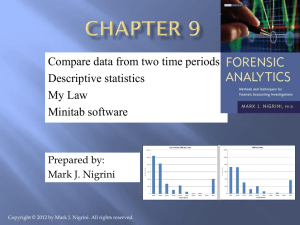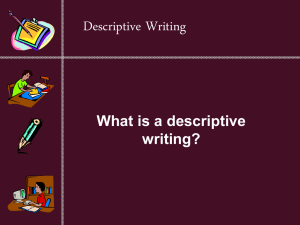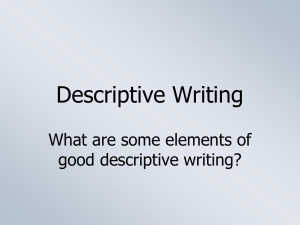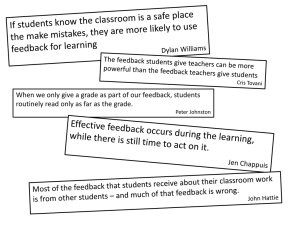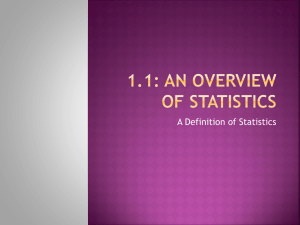Descriptive language - Educational Vision Services
advertisement
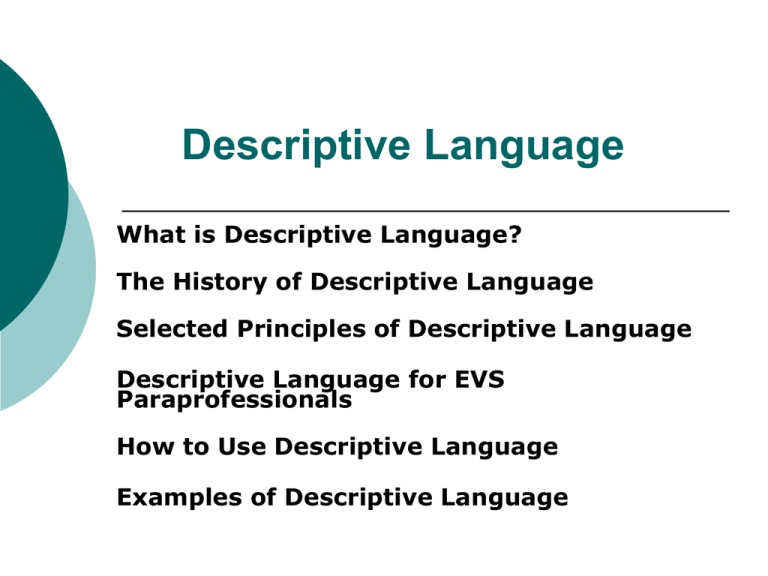
Descriptive Language What is Descriptive Language? The History of Descriptive Language Selected Principles of Descriptive Language Descriptive Language for EVS Paraprofessionals How to Use Descriptive Language Examples of Descriptive Language What is Descriptive Language? Descriptive language means using the appropriate words in just the right way to describe what is “seen” to a person who cannot see or see well. What is Descriptive Language? Descriptive language is different from the ordinary language a person might use to talk about or describe an object a person a situation an activity scene in a play or a movie an exhibit at a museum or other venue Why is Descriptive Language Different? Descriptive language is different because it creates an image that is functional by using words that are purposefully clear specific, and appeal to all the senses The History of Descriptive Language In the 1970s Dr. Margaret Pfansteil and Mr. Cody Pfansteil introduced the idea that language can be used in special ways to describe visual objects, experiences, and activities effectively for people who are blind and visually impaired. The Pfansteils’ goal was to use descriptive language to make live theater and museum exhibits meaningful for people with vision impairments. The History of Descriptive Language Since the 1970s WGBH-TV in Boston, Massachusetts has worked extensively to test and expand the use of descriptive language to film and television. Descriptive language is now well established for use in film, television, theater, and museum or other cultural exhibits. In these venues, descriptive language is known as videodescription or audiodescription. Descriptive Language for EVS Paraprofessionals EVS paraprofessionals can enhance their communication with students who are blind and visually impaired by applying some of the principles WGBH identified for using descriptive language. Selected Principles of Descriptive Language Break up what you are describing into understandable mini-sections Use vivid and detailed language Relate descriptions of size to sizes that are familiar Refer to sound, touch, and any other senses that help make description meaningful Selected Principles of Descriptive Language Refer to the tactile properties of objects you are describing Refer to feeling and emotion, when it is related to what you are describing Encourage tactile exploration that is linked to your verbal description in a meaningful way How to Use Descriptive Language Quickly assess what needs to be described, and describe only what your student needs to know. Remember every student is unique – words that work with one student may not work well with others. Note that situations and tasks vary. Describe accordingly. some situations call for one simple description others call for a series of task-analyzed descriptions How to Use Descriptive Language Describe what you see without interpretation or personal comment. Disappear. A good description directs your student’s attention to what you are describing, not to you. Combine verbal description with physical actions when referring to what you're doing. E.g., when pointing at a display replicating a teacher demonstration How to Use Descriptive Language Arrange a good listening environment. Description is only effective in conducive “listening” environments. Good Listening Environments are Free of extraneous movement not related to your description all forms of multitasking during description distractions side conversations background noise and noisy settings noise from jangling jewelry, rustling papers, etc. How to Use Descriptive Language Remember to be Specific. Avoid vague language, such as “put you papers over here" “line up over there” “do it just like this" Succinct. Don’t be too wordy. Examples of Descriptive Language Break up what you are describing To describe the holiday decorations in your school Start by describing the children’s holiday artwork on the bulletin boards outside the classroom. Then go on to describe the giant plastic candy canes tied in red ribbons at the school’s entrance. Examples of Descriptive Language Use vividly detailed language. Consider the difference between “She looks funny in that hat.” “She is wearing a fuzzy red hat with a big green pom pom that is too big on her.” Examples of Descriptive Language Relate descriptions of size to sizes that are familiar to your student “The fleas in this park are tinier than braille dots.” Examples of Descriptive Language Refer to the tactile properties of objects “The sidewalk ahead of you is broken up and bumpy.” Examples of Descriptive Language Refer to feeling and emotion when it is related to what you are describing “The teacher is motioning for everyone to sit. She looks very serious now.” Examples of Descriptive Language Encourage tactile exploration linked to your verbal description “This is a very big serving spoon, with a deep bowl and long handle. Go ahead and touch it, starting at the bowl and going to the handle.”
